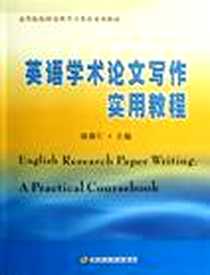《英语学术论文写作实用教程》
《英语学术论文写作实用教程》
出版时间:2012-10
出版社:苏州大学出版社
作者:陈新仁 编
页数:303
字数:425000
《英语学术论文写作实用教程》内容概要[E]
《高校研究性学习英语系列教材:英语学术论文写作实用教程》是一本全面、系统论述英语学术论文写作的佳作。如果你准备或正在撰写英语学术论文,建议你一定要拥有这本书。当你不知从何做起时,这本书会为你指引方向;当你在写作过程中产生疑惑、遇到问题时,它会为你答疑解惑,指点迷津。
《英语学术论文写作实用教程》书籍目录[E]
Unit 1 Rudiments of English Research Paper Writing
Pre-Class Reading
1.1 Defining research paper writing
1.2 Types of research pape
1.3 Principles of research paper writing
1.4 Styles of research paper writing
1.5 Structure of research pape
In-Class Activities
Post.Class Tasks
Unit 2 Designing Titles
Pre-Class Reading
2.1 Criteria for writing titles
2.2 Forms of titles
2.3 Capitalization in titles
2.4 Parallelism in subtitles
2.5 Typical expressio used in titles
2.6 Chinese students’common problems in designing titles
In.Class Activities
Post.Class Tasks
Project Work
Unit 3 Writing Abstracts
Pre-Class Reading
3.1 Move structure of abstracts
3.2 Grammatical features of abstracts
3.3 Typical expressio used in abstracts
3.4 Chinese students’common problems in writing abstracts
In.Class Activities
Post.Class Tasks
Project Work
Unit 4 Introducing the Study
Pre-Class Reading
4.1 General functio of Introduction
4.2 Writing effective introductio
4.3 Typical expressio used in Introduction
4.4 Chinese students’common problems in writing Introduction
In-Class Activities
Post.Class Tasks
Project Work
Unit 5 Presenting the Significance
Pre-Class Reading
5.1 General functio of the Significance section
5.2 Ways of presenting the significance of the study
5.3 Chinese students’common problems in writing the Significance
section
In-Class Activities
Post.Class Tasks
Project Work
Unit 6 Highlighting the Global Structure
Pre-Class Reading
6.1 Defining the global structure
6.2 Highlighting the global structure of a thesis
6.3 Highlighting the global structure of a chapter
6.4 Indicating traitio
6.5 Chinese students’common problems in highlighting the global
structure
In-Class Activities
POst.Class Tasks
Prcaect Work
Unit 7 Planning the Literature Renew
Pre-Class Reading
7.1 Defining Literature Review
7.2 Purposes of Literature Review
7.3 Components of Literature Review
7.4 Organizing Literature Review
7.5 Chinese students’common problems in planning Literature
Review
In-Class Activities
Post-Class Tasks
Project Work
Unit 8 Developing the Literature Renew
Pre-Class Reading
8.1 Features of effective literature reviews
8.2 Steps to develop literature reviews
8.3 Critical respoes to existing studies
In-Class Activities
Post-Class Tasks
Project Work
Unit 9 Stating the Methodology
Pre-Class Reading
9.1 Selecting the research design
9.2 Describing the research design
9.3 Chinese students’common problems in stating the research
design
In-Class Activities
Post.Class Tasks
Prcaect Work
Unit 10 Conducting Analyses
Pre-Class Reading
10.1 Conducting quantitative analyses
10.2 Conducting qualitative analyses
10.3 Discussing the results
10.4 Chinese students’common problems in conducting analyses
In-Class Activities
Post.Class Tasks
Project Work
Unit 11 Making Citatio
Pre-Class Reading
11.1 Defining citation
11.2 Principles of citation
11.3 Methods of citation
11.4 Styles of citation
In-Class Activities
Post—Class Tasks
Project Work
Unit 12 Drawing SummarIesi
Pre-Class Reading
12.1 General functio of summaries
12.2 Writing effective summaries
12.3 Typical expressio used in summaries
12.4 Chinese students’common problems in writing summades
In-Class Activities
Post-Class Tasks
Project Work
Unit 13 Discussing Implicatio and Limitatio
Pre-Class Reading
13.1 Implicatio:Functio and types
13.2 Limitatio:Purposes and elements
13.3 Typical expressio for writing Implicatio and Limitatio
13.4 Chinese students’common problems in writing Implicatio and
Limitatio
In-Class Activities
Post.Class Tasl‘S
Project Work.
Unit 14 Com pos ing Acknowledgem ents
Pre-Class Reading
14.1 Acknowledgements in a thesis
14.2 Targets of acknowledgement
14.3 Ways of acknowledgmem
14.4 Typical expressio used in Acknowledgements
14.5 Chinese students’common problems in composing
Acknowledgments
h1.Class Activities
Post.Class Tasks
Project Work
References
Appendices
1.Declaration
2.APA and MLA Bibliography
3.Supplementary model sentences